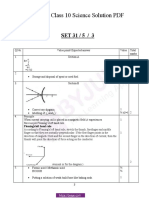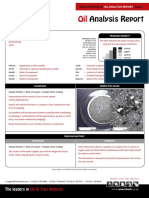MARKING SCHEME
Secondary School Examination, 2023
SCIENCE (Subject Code–086)
[ Paper Code:31/6/2]
Maximum Marks: 80
Q. No. Marks Total
EXPECTED ANSWER / VALUE POINTS
Marks
SECTION—A
1. (b) 1 1
2. (b) 1 1
3. (d) 1 1
4. (d) 1 1
5. (b) 1 1
6. (b) 1 1
7. (d) 1 1
8. (b) 1 1
9. (c) 1 1
10. (a) 1 1
11. (d) 1 1
12. (b) 1 1
13. (c) 1 1
14. (c) 1 1
15. (c) 1 1
16. (d) 1 1
17. (a) 1 1
18. (c) 1 1
19. (d) 1 1
20. (c) 1 1
086_31/6/2_Science # Page-3
� SECTION B
21. (a) A = Lead Nitrate/Pb(NO3)2 ½
B = Nitrogen dioxide/NO2 ½
(b)
Decomposition reaction ½
Double-displacement or Precipitation reaction. ½ 2
22. (a) Medium B ½
In medium B ray of light bends towards normal / r < i ½
(b) Refractive index of Medium B with respect of Medium A is
va
nBA= vb
1
OR
(a)
(Credit marks for i , r and arrows.)
(b)
n2a
n21= ½
n1a
1 33
2 42 ½
or 0·55 2
23. (a)Right-Hand Thumb Rule : Hold the current carrying conductor in
right hand, such that thumb indicates direction of current, then the fingers
will wrap around conductor in the direction of field lines of the magnetic
field. 1
086_31/6/2_Science # Page-4
� Alternate answer of the statement
(b)Fleming’s Left Hand Rule: Stretch the forefinger, middle finger, and
thumb of the left hand such that they are mutually perpendicular to each
other. If the forefinger indicates the direction of the magnetic field, the
1
middle finger indicates the direction of current, then the thumb points in
the direction of motion or force acting on the conductor.
Alternate answer of the statement
All the physical quantities mentioned in the diagram are mutually
perpendicular to each other. 2
24.
6
1
4
1 1 1 2
= ( + ) = => 𝑅𝑝 = 2 ½
𝑅𝑝 4 4 4
2
R=6 + 2 ½
25. Salivary amylase / Ptyalin – Enzyme. ½
Salivary gland ½
The breakdown of starch into sugar will not take place. 1 2
26. (a)
Movement of Leaves of Movement of shoot towards
Sensitive plant light
It is not a growth related It is due to the growth in plant
movement. stem
Fast Slow
086_31/6/2_Science # Page-5
� Reversible response Irreversible response
Non directional movement. Directional movement.
1+1
Stimulus -touch Stimulus -light
or any other (any two)
OR
(b) At synapse the electrical signals are converted into chemicals, that
can easily cross the gap and pass on to the next neurons, where it is
2
again converted into electric signals. In this way the impulse is
2
transmitted from one neuron to another.
SECTION C
27. A solenoid is a coil of many turns of insulated copper wires wrapped 1
closely in the shape of a cylinder
When electric current is passed through it 1
( Deduct ½ mark if direction of current or magnetic field is not marked.)
3
28. • excessive curvature of the eye lens ½
• elongation of the eyeball ½
(a)
(b)
1
3
086_31/6/2_Science # Page-6
�29. (a) Tendrils are sensitive to touch, when they come in contact with any
support.
The part of the tendril in contact with the object does not grow as rapidly
as the part of the tendril away from the object. This causes the tendril to 2
circle around the object and cling to it. 1
Auxin
OR
(b)
Geotropism : - Downward growth of roots/Growth of roots in response to
½,½
gravity.
Hydrotropism : - Movement of roots towards water.
½,½
Chemotropism : - growth of pollen tubes towards ovule in response to
chemical. ½,½ 3
30. Oxygen rich blood from the lungs comes to the left atrium of heart. ½
It then contracts and the blood is transferred to left ventricle. ½
Left ventricle in turn contracts and the blood is pumped out to
the body. ½
Deoxygenated blood from the body enters the right atrium. ½
On its contraction, blood enters into right ventricle ½
Right ventricle pumps it to the lungs for oxygenation ½
3
31. (a) Cu / Copper ½
CuO / Copper Oxide ½
𝐻𝑒𝑎𝑡
(b) 2Cu + O2 → 2CuO 1
CuO + H2 → Cu + H2O 1 3
32. (a) (i) Chemical Name : Calcium Carbonate ½
Chemical formula : CaCO3 ½
(ii) CaCO3 + 2HCl → CaCl2 + H2O + CO2 1
Ca(OH)2 + CO2 → CaCO3 + H2O 1
OR
(b) (i) Hydrogen / H2 ½
(ii) The gas burns with a pop sound ½
(iii) (1) 2HCl + Zn → ZnCl2 + H2 1
(2) 2NaOH + Zn → Na2ZnO2 + H2 1 3
086_31/6/2_Science # Page-7
�33. Peacock ½
Because peacock is occupying the top level of this food chain and the
concentration of these non-biodegradable chemicals increase as we move 1
up in a food chain.
Process involved - Biomagnification ½
The increase in the concentration of harmful chemicals or (non-
biodegradable substances) which accumulate progressively in the 1
successive trophic levels of a food chain. 3
SECTION D
34. (a) (i) Compounds having same molecular formula but different structural 1
formula
Structures are :
O
||
CH3CH2 — C — H Propanal ½,½
O
|| ½,½
CH3 — C — CH3 Propanone
(ii)
Soaps are sodium or potassium salts of long-chain carboxylic acids / ½
- +
R-COO Na
detergents are ammonium salts with chlorides or bromides ions or
Sodium salts of sulphonic acids/ R-OSO3- Na+ ½
Soaps react with calcium or magnesium ions present in hard water to
form an insoluble substance / soaps react with hard water forming scum. 1
OR
(b)
(i) A series of compounds in which the same functional group substitutes
for hydrogen in a carbon chain / having similar chemical. properties and
differ by– CH2. 1
General formula CnH2n-2
Ethyne ½
086_31/6/2_Science # Page-8
� Electronic dot structure ½
(ii) Functional group is an atom or a group of atoms (hetero atom) bonded
to a carbon chain. It defines the chemical property of the organic
1
compound.
Alcohol – OH ½
O
|||
Carboxylic Acid – COOH / — C — OH
½
5
35. (a) (i) The property of conductor to resist the flow of charges through 1
it.
If potential difference across the two ends of a conductor is 1V and the
current through it is 1A, then resistance ‘R’ of the conductor is 1. 1
Alternate answer
1 volt lV
1 = /
1 ampere 1A
(ii)
Length of the conductor
Area of cross-section of the conductor
Nature of the material
½,½
Temperature ( any two)
(iii) (1) The resistance will become one half of its original value.
l l ½
R=ρ =ρ 2
A πr
𝜌. 2𝐿
𝑅′ = ½
𝜋(2𝑟)2
(2)
𝜌. 𝑙 2 𝑅
𝑅′ = . =
𝜋(2𝑟)2 4 2 ½
Resistance will reduce to one half. ½
OR
086_31/6/2_Science # Page-9
� (b) (i) No 1
In series combination overall resistance will increase hence
1
decreasing the current . Potential difference also divides. Therefore power
consumption is less by each bulb and glows with less brightness.
1
In parallel combination each bulb will get the required potential
difference hence the required current and will glow with its normal
brightness.
(ii) None of the bulb glows in series combination as the circuit gets 1
broken and current stops flowing.
In parallel combination the other two bulbs will glow with same 1
brightness as the same voltage is available to them.
5
36. (a) As DNA is the information source for making proteins. If the
information is changed, different protein will be made and will lead 1
to altered body design.
(b) In the absence of pollination no male gametes will be available
1
for fertilisation.
(c) Because in many multi cellular organisms specialised cells are
organised into tissues, tissues form organ occupying definite 1
positions in the body.
(d) 1. Plants can bear flowers and fruits earlier than those produced
from seeds.
2. It enables the propagation of plants such as banana, orange, rose
and jasmine which have lost the capacity to produce seeds.
3. The plants produced are genetically similar enough to the parent
plant to have all the characteristics ½,½
(any one point)
(e) During gamete formation the number of chromosomes is reduced to
half. When the zygote is formed / at the time of fertilisation, fusion of
1 5
male and female gametes restores the original number of chromosomes in
the offspring as in the parent.
SECTION E
37. (a) Real, inverted, diminished (Any two) ½,½
(b) Case II ½
Because focal length of mirror is 15 cm, object distance is 30cm which
means the object is placed at C. ½
086_31/6/2_Science # Page-10
� (c) Dentists use concave mirrors 1
Because concave mirror forms erect and enlarged image when the object 1
is very close to the mirror.
OR
(c) Case III 1
4
( Deduct ½ mark if direction of ray is not marked.)
38. (a) By electrolytic reduction 1
(b) Carbon cannot reduce the oxides of highly reactive metals / 1
these metals have more affinity for oxygen than carbon.
(c) When Cinnabar is heated in the presence of air, it is first converted
into mercuric oxide. / This is then reduced to mercury. 1
heat
2HgS + 3O2 ⎯⎯ ⎯→ 2HgO + 2SO2 ½
heat ½
2HgO ⎯⎯ ⎯→ 2Hg + O2
OR
(c)
Roasting Calcination
A process in which sulphide ores are A process in which carbonate
converted into oxides by heating ores are heated in limited
strongly in the presence of excess air supply air.
heat heat
2ZnS + 3O2 ⎯⎯ ⎯→ 2ZnO + 2SO2 ZnCO3 ⎯⎯ ⎯→ ZnO + CO2
2
(or any other)
4
39. (a) Zygote – 23 pairs / 46 chromosomes. ½
Gamete – 23 chromosomes. ½
(b) The temperature at which fertilised eggs are kept determines
whether the animals developing in the eggs are male or female. 1
086_31/6/2_Science # Page-11




























































































